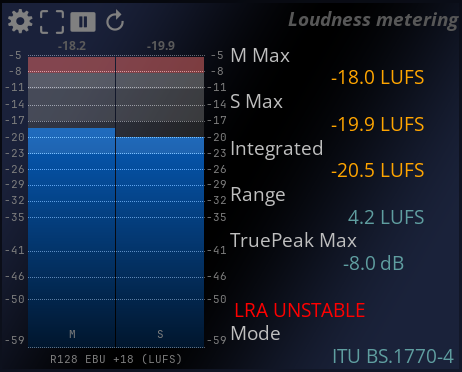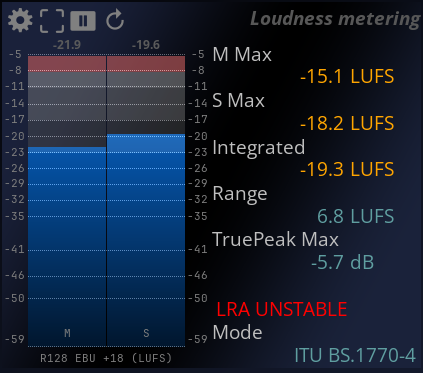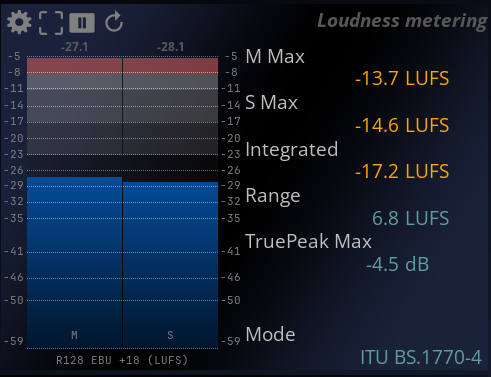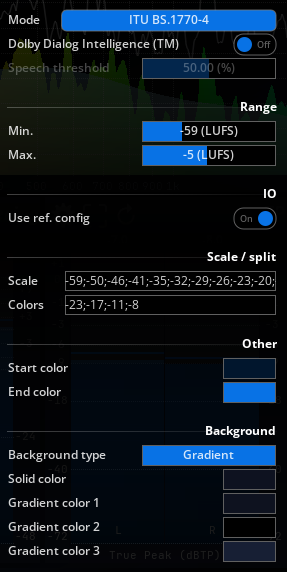Loudness metering
Loudness ITU-R BS 1770 and EBU R128 PLOUD
ITU-R BS.1170-4 and EBU R128 recommendations introduce a new paradigm for audio metering, which define a way to measure the perceived loudness of audio material in a normalized and reproducible manner.
Please refer to the official documents freely available online at tech.ebu.ch/groups/ploud * or consult a reference book such as “Audio Metering. Measurements, standards and practice” by Eddy Brixen (Focal Press, ISBN 9780240814674) for detailed information on this subject.
Principles
Units
ITU-R BS.1170-2 notably defines LU (Loudness Unit) and LUFS (Loudness Unit, referenced to Full Scale) units, which are used by EBU R128, and Maximum True Peak Level.
LU is used for measurements relative to a reference level and measuring range.
LUFS is used for absolute measurements.
The meter display is switchable between LUFS (absolute, default) and LU (relative). The target loudness level to aim for is -23 LUFS = 0 LU.
Some documentation refers to the LKFS unit. LUFS and LKFS are synonymous, but LUFS should be used as it conforms to scientific unit notation.
Loudness and EBU mode
EBU mode specifies three time scales corresponding to three different, complementary loudness levels
- M: Momentary, 400ms integration time
- S: Short-term, 3s integration time
- I: Integrated from start of measurement or last reset, gated
Loudness is a measure of global loudness, so individual channel metering is irrelevant in this context.
No additional slowdown of the attack or release of the meter is employed, as indicated by the norm.
The integrated loudness can be understood as the overload loudness of the audio over time, excluding very soft passages through the use of absolute and relative gating.
Loudness Range (LRA)
Loudness range measures the average long-term variations of the loudness; it is expressed in LU.
Scales
EBU R128 specifies two normalized scales:
- EBU +9, ranging from -18.0 LU to +9.0 LU (-41.0 LUFS to -14.0 LUFS)
- EBU +18, ranging from -36.0 LU to +18.0 LU (-59.0 LUFS to -5.0 LUFS) (Default)
Dolby Dialogue Intelligence
Introduction
While EBU R128 aims to measure global perceived loudness, irrespectively of the audio material, Dolby Dialogue Intelligence is a patented technology designed to specifically measure the perceived loudness of dialogue elements in the audio. It is therefore targeted towards broadcast applications.
General principle
Dialogue Intelligence replaces EBU R128’s level-based gate with a speech-content ratio based gate. The algorithm computes several low-level features for the incoming signal in speech channels. These are then combined into an overall speech percentage figure. When speech content is detected, Integrated Loudness is computed from the speech channels which have a speech content ratio above a certain threshold.
When another material is detected, i.e. not speech, standard EBU R128 Integrated Loudness computation is employed.
Display
The current speech content is displayed as text below the current gate status.
Additionally, color coding indicates the speech content ratio.
- Speech : speech content present
- Green: high speech content
- Orange: medium speech content
- Red: low speech content
- Other: other material present
Delay and compensation
The sophistication of the algorithms employed in Dialogue Intelligence incurs an overall latency of 2048ms (approx. 2s).
When Dialogue Intelligence is enabled, the display of other Loudness values is compensated to make sure meter readings are consistent. Other real-time meter (RMS, TruePeak) displays are not compensated, as we feel, in this case, maintaining the best reactivity to the incoming signal is more important.
All meter statistics are time-aligned.
Surround
Channels taken into account by the algorithm are determined based on the current channel configuration.
For mono/stereo signals, all channels are taken into account. For surround configurations, only Left/Right and Center channels are considered, if present.
Dialogue Intelligence computation only affects I (Integrated) Loudness values.
Toggling Dialogue Intelligence on and off forces a reset of the meter values.
Controls and display
Display
The meter display has the following arrangement:
left bar: Momentary Loudness value
right bar: Short-term Loudness
text overlay: Integrated Loudness and Loudness Range (LU) values, Gated indicator lights red when the gate is active
The Loudness Range value is displayed once the measurement has been running for at least 60 seconds, according to the EBU Tech 3342 specification, otherwise a ‘LRA Unstable’ warning is shown.
Pause
Clicking the  button pauses measurement; clicking again resumes it. This allows you to make adjustments without affecting Integrated Loudness, instead of having to start all over again.
button pauses measurement; clicking again resumes it. This allows you to make adjustments without affecting Integrated Loudness, instead of having to start all over again.
Reset
Clicking the  button resets the meter to its initial state.
button resets the meter to its initial state.
Don’t forget to reset the Loudness meter if you’re starting playback of a new track, as Integrated Loudness, by design, measures the overall Loudness since the last reset.
Otherwise, you’d be measuring the overall Loudness of the combined tracks, which is probably not what you want.
Settings
Mode
Change the targeted integrated loudness as well as the maximum True Peak level.
| Name | Description |
|---|---|
| ITU BS.1770-1 | Defined as a maximum integrated level of -24 LUFS and a maximum True Peak level of -2 dBFS. You can read the official publication here. |
| ITU BS.1770-2 | Defined as a maximum integrated level of -24 LUFS and a maximum True Peak level of -2 dBFS. You can read the official publication here. |
| ITU BS.1770-3 | Defined as a maximum integrated level of -24 LUFS and a maximum True Peak level of -2 dBFS. You can read the official publication here. |
| ITU BS.1770-4 | Defined as a maximum integrated level of -24 LUFS and a maximum True Peak level of -2 dBFS. You can read the official publication here. |
| EBU R128 | The EBU R128 is European TV Broadcasting standard. It is defined as a maximum integrated level of -23 LUFS with a tolerance of 0.5 LUFS and a maximum True Peak level of -1 dBFS. You can read the official publication here. |
| EBU R128 S1 | The EBU R128 S1 is a supplement of the EBU R128 for short-form content like advertisements (commercials) and promos (as well as interstitials, etc.). For such programs, there is a need to give guidance using maximum short-term loudness in addition to the integrated loudness and the maximum true peak level. It defines a maximum integrated level of -23 LUFS, a maximum short-term loudness of -18 LUFS and a maximum True Peak level of -1 dBFS. You can read the official publication here. |
| ARIB TR-B32 | The TR-B32 recommendation from the Association of Radio Industries and Businesses (ARIB) in Japan provides guidelines for broadcasting, focusing on loudness management to ensure consistent and high-quality audio. It specifies a target loudness level of -24 LUFS and a true peak limit of -1 dBTP to prevent distortion. Measurements should comply with the ITU-R BS.1770 standard. You can read the official publication here. |
| ATSC A/85 (2011) | The A/85 recommendation from the Advanced Television Systems Committee (ATSC), published in 2011, provides guidelines for audio loudness management in broadcasting to ensure a consistent and high-quality listening experience. It specifies a target loudness level of -24 LUFS and a true peak limit of -2 dBTP (decibels True Peak) to prevent distortion. Measurements should comply with the ITU-R BS.1770 standard. |
| ATSC A/85 (2013) | The 2013 revision of the A/85 recommendation from the Advanced Television Systems Committee (ATSC) builds upon the 2011 guidelines to further refine and clarify loudness management practices in broadcasting. While keeping the same target levels, it now refers to compliance toward the third revision of the ITU-BS.1770. You can read the official publication here. |
| Free TV OP-59 | The OP-59 recommendation from Free TV, Australia, provides guidelines for the measurement and management of loudness in television broadcasting. It specifies a target loudness level of -24 LUFS and a true peak limit of -2 dBTP. You can read the official publication here. |
| AGCOM 219/09/CSP | The 219/09/CSP recommendation from AGCOM (Autorità per le Garanzie nelle Comunicazioni), Italia, provides guidelines for the measurement and management of loudness in television broadcasting. It specifies a target loudness level of -24 LUFS and a true peak limit of -2 dBTP. You can read the official publication here. |
| Portaria 354 | The Portaria 354 is a standard defined by the Ministry of Communications, Brazil based on ITU-R BS.1770-2 and EBU R128 (2011) with the integrated target level of -23 LUFS and a target true peak of -2 dBFS. You can read the official publication here. |
| Sony R001 HOME | For home-based SCE platforms, the average loudness level of audio content should be normalized to a target of -24 (±2) LUFS. Additionally, the maximum true peak level should not exceed -1 dBTP, using a meter compliant with both ITU-R BS.1770-3 and EBU Tech Doc 3341. You can read the official publication here. |
| Sony R001 PORTABLE | Analogous to the home version, but the average loudness level of audio content should be normalized to a target of -18 (±2) LUFS. You can read the official publication here. |
| AES Streaming | The AES Technical Document TD1004.1.15-10 recommends that the Target Loudness of audio streams should not exceed -16 LUFS to prevent excessive peak limiting and should not be lower than -20 LUFS to ensure audibility on mobile devices. Short-form programming, such as commercials, should have a Maximum Short-term Loudness of no more than 5 LU higher than the Target Loudness. Additionally, the maximum peak level should not exceed -1.0 dB TP. The metering should conform to the EBU R-128. You can read the official publication here. |
| Spotify | Spotify is a music streaming service which recommends a normalization of the integrated level at -14 LUFS and limiting the true peaks at -1 dBTP. Audio contents that don’t meet this loudness requirement will be attenuated if too loud and amplified if too quiet. Not that no limiting is applied if the audio is too low and the algorithm preserves a headroom of 1 dBTP. You can read the official publication here. |
| Spotify Loud | The loud mode in the Spotify application applies a limiter to normalize the integrated level of audio content up to -11 LUFS while leaving the maximum true peak at -2 dBTP. Our metering reflects on these two values. You can read the official publication here. |
| YouTube | Youtube is a video hosting web site which provides a similar recommendation to Spotify by normalizing the content to -14 LUFS-I and by leaving the maximum true peak at -1 dBTP. |
| Apple Music and Podcast | Apple Music is a music streaming service which provides a different set of recommendations: - A targeted loudness of -16 LUFS with a tolerance of 2 LU |
| TIDAL | TIDAL is a music streaming service. Its recommendations are identical to Spotify. |
| Amazon Music. and Alexa. | Amazon, through its music streaming services, recommends a LUFS-I of -14 and a maximum true peak of -2 dBTP. |
| Deezer | Deezer is a music stream service which recommends -15 LUFS-I and a maximum true peak of -1 dBTP. |
| Netflix | Netflix is a web service of video on demand. It recommends an integrated loudness target of -27 LUFS with a maximum true peak of -2 dBTP. |
| AES TD1008 | The AES TD1008 is an international streaming service recommendation toward loudness level of audio content. It recommends a target of -16 LUFS-I with a tolerance of 2 LU. The maximum true peak should not exceed -1 dBTP. You can read the official publication here. |
Dolby Dialogue Intelligence
| Name | Description |
|---|---|
| Dolby Dialogue Intelligence (TM) | Toggles usage of Dolby Dialogue Intelligence speech gate. |
| Speech threshold | Defines the speech content threshold in %. Speech channels with a speech content ratio below this value do not participate in the Loudness computation. |
Range
| Name | Description |
|---|---|
| Min. | Minimum Loudness to display on the bar-graphs. |
| Max. | Maximum Loudness to display on the bar-graphs. |
IO
| Name | Description |
|---|---|
| Use input (reference) layout | Define if the number of channels displayed by the meter reflects the current input reference layout or the number of channels of the system tuning inputs. |
Scale/split
| Name | Description |
|---|---|
| Scale | Meter labels are defined here as a comma separated list of dB values to be shown on the side of the meters. This also defines where the corresponding horizontal markings are. Default is -72;-40;-18;-9;-6;-3;-1;0;1;3. |
| Colors | This lets you customize the values at which color transitions occur. You can enter as many values as you wish, as a comma separated list, but make sure the values are in increasing order. Default is -9;0. The last value always defines the clip level, which will be indicated in red. |
Other
| Name | Description |
|---|---|
| Start color | Define the bottom color of the gradient used to draw the bar graph. |
| End color | Define the top color of the gradient used to draw the bar graph. |



